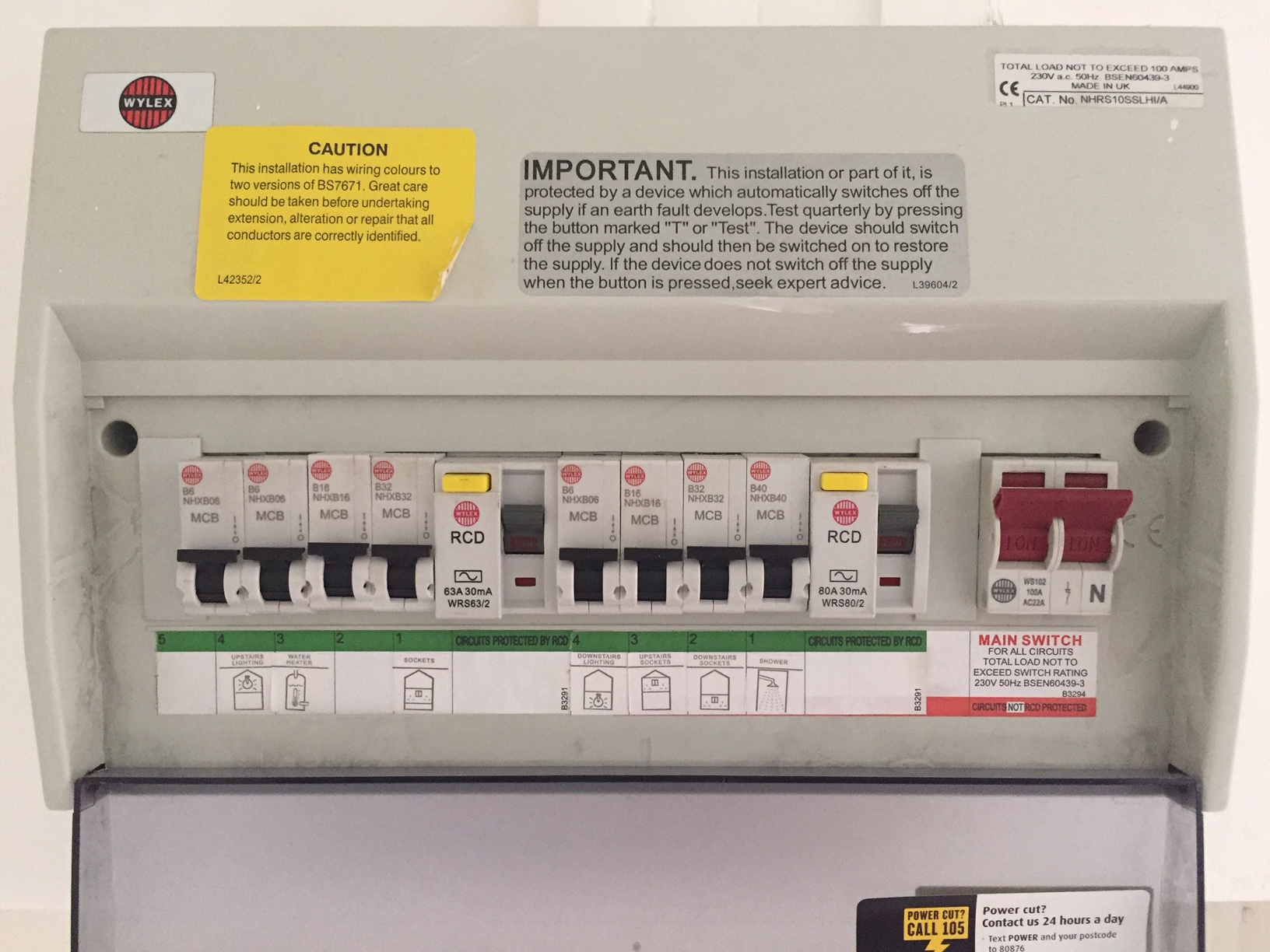Consumer unit
This term 'consumer unit' is now officially defined within the 2018 edition of BS 7671 (IET Wiring Regulations) as:
| A particular type of distribution board comprising a type-tested co-ordinated assembly for the control and distribution of electrical energy, principally in domestic premises, incorporating manual means of double pole isolation on the incoming circuit(s) and an assembly of one or more fuses, circuit breakers, residual current operated devices or signalling and another control devices proven during the type-test of the assembly as suitable for such use. |
To many, the consumer unit is the modern-day equivalent of a ‘fuse box’ or ‘fuse board’ and provides the origin of all outgoing final circuits.
Successive evolutions of BS 7671 over the last few decades have seen the requirements for consumer units grow substantially – not only in what they may house, but also their construction – particularly in recent years with regards to increased fire safety.
The most recent version of BS 7671 in 2018 (the 18th Edition) now imposes much greater emphasis on ensuring that all such equipment that may be housed in such a consumer unit, often to fulfil specific individual purposes, is properly considered with respect to how it performs alongside other equipment in its vicinity. This will include attributes such as thermal performance, magnetic effects, fixing details and terminations, ability to withstand fault levels as well as current carrying capacity.
--ECA
NB Housing statistics and English Housing Survey, glossary, published by the Department for Levelling Up, Housing and Communities in 2019, states: ‘…in older systems, each individual electrical circuit was fed through an individual switch and fuse box. From 1960s through to the 1980s, fuses were collected together into a small number of smaller boxes, normally with a switch on the front which controlled all the circuits leading to the box. These boxes were normally fitted with a cover, the removal of which gave access to the fuses hidden inside. From the early 1980s, the newly named consumer unit (some dwellings have 2) catered for the whole dwelling and was also designed to accommodate modern safety measures namely circuit breakers and residual current devices.’
Related articles on Designing Buildings
- Articles about electricity.
- Circuit breaker.
- Consumer electronics.
- Domestic micro-generation.
- ECA articles.
- Electric motor.
- Electrical appliance.
- Electrical component.
- Electrical consumption.
- Electrical energy.
- Electrical installation.
- Electrical power.
- Electrician.
- Electrical safety.
- Electricity bill.
- Electricity supply.
- Flexible electrical networks for a low carbon future.
- Fuse.
- Glossary of electrical terms.
- Miniature circuit breaker.
- Panelboard.
- Radial circuit.
- Residual current device.
- The Future of Electricity in Domestic Buildings.
Featured articles and news
RTPI leader to become new CIOB Chief Executive Officer
Dr Victoria Hills MRTPI, FICE to take over after Caroline Gumble’s departure.
Social and affordable housing, a long term plan for delivery
The “Delivering a Decade of Renewal for Social and Affordable Housing” strategy sets out future path.
A change to adoptive architecture
Effects of global weather warming on architectural detailing, material choice and human interaction.
The proposed publicly owned and backed subsidiary of Homes England, to facilitate new homes.
How big is the problem and what can we do to mitigate the effects?
Overheating guidance and tools for building designers
A number of cool guides to help with the heat.
The UK's Modern Industrial Strategy: A 10 year plan
Previous consultation criticism, current key elements and general support with some persisting reservations.
Building Safety Regulator reforms
New roles, new staff and a new fast track service pave the way for a single construction regulator.
Architectural Technologist CPDs and Communications
CIAT CPD… and how you can do it!
Cooling centres and cool spaces
Managing extreme heat in cities by directing the public to places for heat stress relief and water sources.
Winter gardens: A brief history and warm variations
Extending the season with glass in different forms and terms.
Restoring Great Yarmouth's Winter Gardens
Transforming one of the least sustainable constructions imaginable.
Construction Skills Mission Board launch sector drive
Newly formed government and industry collaboration set strategy for recruiting an additional 100,000 construction workers a year.
New Architects Code comes into effect in September 2025
ARB Architects Code of Conduct and Practice available with ongoing consultation regarding guidance.
Welsh Skills Body (Medr) launches ambitious plan
The new skills body brings together funding and regulation of tertiary education and research for the devolved nation.
Paul Gandy FCIOB announced as next CIOB President
Former Tilbury Douglas CEO takes helm.
UK Infrastructure: A 10 Year Strategy. In brief with reactions
With the National Infrastructure and Service Transformation Authority (NISTA).

























Comments
[edit] To make a comment about this article, click 'Add a comment' above. Separate your comments from any existing comments by inserting a horizontal line.